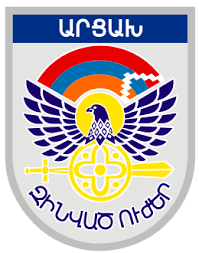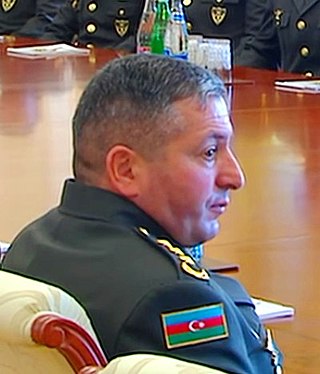
The First Nagorno-Karabakh War was an ethnic and territorial conflict that took place from February 1988 to May 1994, in the enclave of Nagorno-Karabakh in southwestern Azerbaijan, between the majority ethnic Armenians of Nagorno-Karabakh backed by Armenia, and the Republic of Azerbaijan with support from Turkey. As the war progressed, Armenia and Azerbaijan, both former Soviet republics, entangled themselves in protracted, undeclared mountain warfare in the mountainous heights of Karabakh as Azerbaijan attempted to curb the secessionist movement in Nagorno-Karabakh.

The Artsakh Defence Army was the defence force of the breakaway Republic of Artsakh. Established in 1992, it united previously disorganized defence units which were formed in the early 1990s.

The Nagorno-Karabakh conflict was an ethnic and territorial conflict between Armenia and Azerbaijan over the region of Nagorno-Karabakh, inhabited mostly by ethnic Armenians until 2023, and seven surrounding districts, inhabited mostly by Azerbaijanis until their expulsion during the 1990s. The Nagorno-Karabakh region was entirely claimed by and partially controlled by the breakaway Republic of Artsakh, but was recognized internationally as part of Azerbaijan. Azerbaijan gradually re-established control over Nagorno-Karabakh region and the seven surrounding districts.

There are no diplomatic relations between Armenia and Azerbaijan. The two neighboring states had formal governmental relations between 1918 and 1921, during their brief independence from the collapsed Russian Empire, as the First Republic of Armenia and the Democratic Republic of Azerbaijan; these relations existed from the period after the Russian Revolution until they were occupied and annexed by the Soviet Union, becoming the constituent republics of Soviet Armenia and Soviet Azerbaijan. Due to the five wars waged by the countries in the past century—one from 1918 to 1921, another from 1988 to 1994, and the most recent in 2016, 2020 and 2023 —the two have had strained relations. In the wake of hostilities, social memory of Soviet-era cohabitation is widely repressed.

Aghdam is a ghost city and the nominal capital of the Aghdam District of Azerbaijan. Founded in the 18th century, it was granted city status in 1828 and grew considerably during the Soviet period. Aghdam lies 26 km from Stepanakert at the eastern foot of the Karabakh Range, on the outskirts of the Karabakh plain.

The 2008 Mardakert clashes began on March 4 after the 2008 Armenian election protests. It involved the heaviest fighting between ethnic Armenian and Azerbaijani forces over the disputed region of Nagorno-Karabakh since the 1994 ceasefire after the First Nagorno-Karabakh War.
Seysulan is a village in the Tartar District of Azerbaijan, in the disputed region of Nagorno-Karabakh. The village was on the ceasefire line between the armed forces of Artsakh and Azerbaijan prior to the Azerbaijani offensive in September 2023. The village had an ethnic Armenian-majority population in 1989.

Talish is a village in the Aghdara District in Azerbaijan, in the disputed region of Nagorno-Karabakh. The village had an ethnic Armenian-majority population prior to the 2020 Nagorno-Karabakh war, and also had an Armenian majority in 1989.
Mubariz Aghakerim oğlu Ibrahimov was an Azerbaijani Warrant Officer and National Hero of Azerbaijan.
The 2010 Nahorno karabakh war were a series of exchanges of gunfire that took place on February 18 on the line of contact dividing Azerbaijani and the Karabakh Armenian military forces. Azerbaijan accused the Armenian forces of firing on the Azerbaijani positions near Tap Qaraqoyunlu, Qızıloba, Qapanlı, Yusifcanlı and Cavahirli villages, as well as in uplands of Agdam Rayon with small arms fire including snipers. As a result, three Azerbaijani soldiers were killed and one wounded.

United Nations General Assembly Resolution 62/243, titled "The Situation in the Occupied Territories of Azerbaijan", is a resolution of the United Nations General Assembly about the situation in Nagorno-Karabakh, which was adopted on March 14, 2008 at the 62nd session of the General Assembly. It became the seventh United Nations document concerning Nagorno-Karabakh and the third and last United Nations General Assembly document on it.

The 2012 border clashes between the armed forces of Armenia and Azerbaijan took place in early June. The clashes resulted in casualties on both sides.

Clashes on the Armenian–Azerbaijan border (Tavush–Qazakh) and the line of contact between the Nagorno-Karabakh and Azerbaijan started on 27 July 2014. Reported casualties of the clashes were some of the highest since the 1994 ceasefire agreement that ended the First Nagorno-Karabakh War.

On 12 November 2014, an Armenian Mil Mi-24 attack helicopter was shot down by Azerbaijani Armed Forces during the Nagorno-Karabakh conflict, killing all three crew members.

The 2016 Nagorno-Karabakh conflict, also known as the Four-Day War, April War, or April clashes, began along the former Nagorno-Karabakh line of contact on 1 April 2016 with the Artsakh Defence Army, backed by the Armenian Armed Forces, on one side and the Azerbaijani Armed Forces on the other.
Kyaram or Qyaram Sloyan was an Artsakh Defense Army soldier who was killed during the 2016 Armenian–Azerbaijani clashes. After his death, he was beheaded, with videos and pictures showing Azerbaijani soldiers posing with his severed head posted on social networks.

Shukur Nariman oğlu Hamidov was an Azerbaijani officer, national hero and colonel of the Armed Forces of Azerbaijan. He was son to Nariman and Shargiya Hamidov. He was an enlisted member of the army since a young age and had experienced multiple wars. His family were refugees from Armenia that later migrated to Azerbaijan.

The Line of Contact was the front line which separated Armenian forces and the Azerbaijan Armed Forces from the end of the First Nagorno-Karabakh war until the 2020 Nagorno-Karabakh ceasefire agreement.

The military forces of Armenia and Azerbaijan have been engaged in a border conflict since 12 May 2021, when Azerbaijani soldiers crossed several kilometers into Armenia in the provinces of Syunik and Gegharkunik. Despite international calls for withdrawal from the European Parliament, the United States, and France, Azerbaijan has maintained its presence on Armenian soil, occupying at least 215 square kilometres (83 sq mi) of internationally recognized Armenian territory. This occupation follows a pattern of Azerbaijan provoking cross-border fights and instigating ceasefire violations when its government is unhappy with the pace of negotiations with Armenia.
The Susuzluq explosion was a mine explosion in the vicinity of the village of Susuzluq in Azerbaijan's Kalbajar region, which occurred on 4 June 2021. The explosion killed 3 people, two of them journalists, and wounded another 4. This is the first case of journalist death on Azerbaijani territory after the 2020 Nagorno-Karabakh war.












